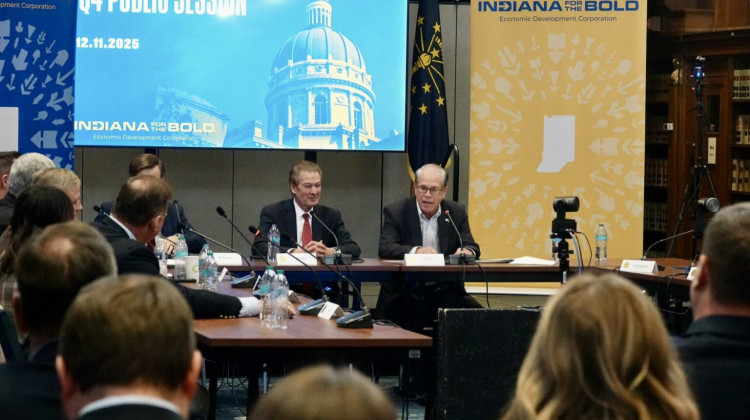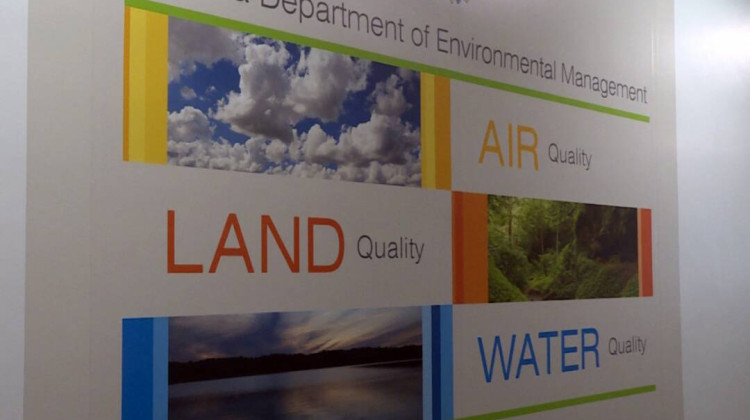
From left to right, Rep. Greg Steuerwald (R-Danville), House Speaker Todd Huston (R-Fishers) and Rep. Tim Wesco (R-Osceola) discuss the proposed Indiana House and Congressional district maps.
Brandon Smith/IPB NewsIndiana House Republican leaders Wednesday defended the redistricting maps they unveiled this week.
The proposed Indiana House district map draws six districts that include two current Republican lawmakers. That includes:
- Rep. Curt Nisly (R-Milford) in a district with Rep. Craig Snow (R-Warsaw)
- Rep. Doug Gutwein (R-Francesville) in a district with Rep. Don Lehe (R-Brookston)
- Rep. Tim Brown (R-Crawfordsville) in a district with Rep. Beau Baird (R-Greencastle)
- Rep. Tony Cook (R-Cicero) in a district with House Speaker Todd Huston (R-Fishers)
- Rep. Sean Eberhart (R-Shelbyville) in a district with Rep. John Young (R-Franklin)
- Rep. Steve Davisson (R-Salem) in a district with Rep. Jim Lucas (R-Seymour)
Such districts happen every redistricting cycle. And some of those incumbents will likely retire, meaning there will be few Republican primary races between existing lawmakers.
For the last 10 years, Indiana’s Congressional map produced seven Republican districts and two Democratic ones. That’s likely unchanged in the new map – although District 5, in central Indiana, appears to be redrawn by the GOP to make it less competitive and more solidly Republican.
Speaker Huston said the maps honored the goals he and his fellow leaders set out: districts that follow the law, are as compact as possible and keep communities of interest together.
“People are going to think what they want to think," Huston said. "But I think we can stand behind coming here, presenting very – maps that met the goals that we had.”
Asked specifically, though, about district changes that favor Republicans – Huston’s own House district and the 5th Congressional District, for instance – Huston would only say population shifts were the primary driver of such changes.
Critics, however, note that in recent statewide elections, Republicans typically get around 60 percent of the statewide vote compared to Democrats' 40 percent – while the makeup of the Indiana House is currently 71 percent Republican, 29 percent Democratic.
And Rep. Greg Steuerwald (R-Danville), the author of the redistricting legislation, acknowledged Wednesday that the House Republican Campaign Committee consulted on the new maps.
The new Indiana House map would create six new "open" districts, meaning no current lawmaker lives in them. At least one analysis of those new seats – when comparing them to 2020 presidential election results – suggests at least two of them favor Democrats.
There could be further alterations to the proposed maps – potentially influenced, Huston said, by testimony from members of the public in House committee hearings this week.
“There is no perfect in this process and if people bring substantive, well thought out arguments, they will certainly be considered,” Huston said.
Very few people showed up Wednesday to the first of two House Elections Committee hearings this week at the Statehouse on the proposed redistricting maps.
Join the conversation and sign up for the Indiana Two-Way. Text "Indiana" to 73224. Your comments and questions in response to our weekly text help us find the answers you need on statewide issues.
Several Hoosiers who testified Wednesday, like Polly Spiegel, said the release of the proposed maps Tuesday was too close to the public hearing.
“So, now the legislature is taking what is supposed to be public testimony from a public that knows very little more than they did before the maps were released," Spiegel said. "No time for analysis.”
Few specific recommendations for changes to the maps were proposed. Instead, the arguments centered on overall concepts of fairness and competitiveness.
Others who testified also objected to the time and place of the hearing. Too few Hoosiers, they argued, could show up to the Statehouse on a Wednesday afternoon.
In the normal redistricting process, which typically occurs in April, hearings (like all legislative committee meetings during the General Assembly's sessions) happen in the morning or afternoon on weekdays at the Statehouse.
The House Elections Committee will vote on the proposed maps next week.
Contact reporter Brandon at bsmith@ipbs.org or follow him on Twitter at @brandonjsmith5.
 DONATE
DONATE








 Support WFYI. We can't do it without you.
Support WFYI. We can't do it without you.